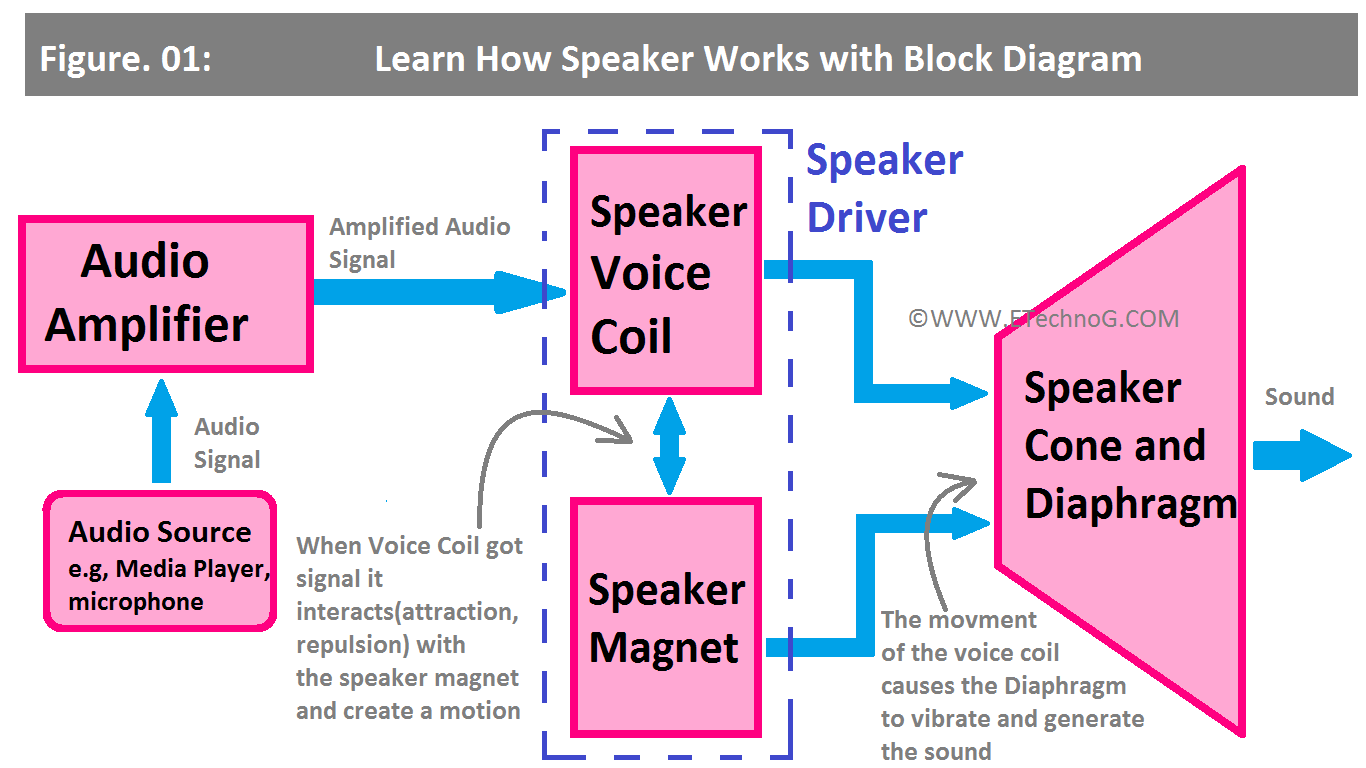How Speaker Works? Learn with Block Diagram
In our daily life, you can see, there are so many applications or uses of speakers from our mobile phones to TV, Radio, etc. The working principle of the speaker is very simple. You will easily understand it. Let’s learn how a speaker works with a block diagram.
Working principle of Speaker
The working principle of the speaker is based on the interaction of a permanent magnet and an electromagnet.
Let's start with the audio sources. There are various types of audio sources such as microphones, Media players, MP3 Players, CDs, DVDs, etc. These primary audio sources are not able to drive a speaker as their output power is very low. In this case, we need an audio amplifier that will amplify this weak signal into a strong high-power audio signal that can easily operate the speaker.
When the audio signals(basically a pulse current and voltage) from the audio devices are fed to a speaker, the voice coil of that speaker got energized and it becomes an electromagnet. Once the voice coil got a signal it generates the magnetic pole and starts interaction with the permanent magnet of the speaker. Remember that the combination of the voice coil and the permanent magnet is also called a speaker driver.
The voice coil continuously changes its pole according to the audio signal applied. If the same pole is generated in the electromagnet or Voice coil as the permanent magnet pole, they repulse each other and if the opposite pole is generated then they attract to each other. As the voice coil is very light in weight and free to move, so it will start moving up and down due to the interaction and repulsion according to the pulse current or the audio signal.
This movement of the voice coil makes the speaker cone or diaphragm to vibrating and finally create the sound.
Read Also: Audio Devices Examples and Their Uses
Construction of a Simple Speaker
The speaker has a permanent magnet and an electromagnet(that is known as a voice coil). A coil of very thin copper wire is used as an electromagnet. We already know that if current flow through a coil then it becomes an electromagnet. This electromagnet has a pole that can be changed. But the poles of the permanent magnet cannot be changed.
Generally, the voice coil is made with copper wires. The coil of copper wire or electromagnet is placed inside the poles of the permanent magnet with a former. The purpose of the former is to hold the speaker cone. The speaker cone (Diaphragm) is glued to the voice coil former. And the suspension is glued on the frame. The permanent surrounded the electromagnet. The spiders are used on two sides of the voice coil which allows the voice coil to move only up and down not sideways. The dust cap is used to protect the voice coil from dust. These magnets are placed in a frame of a metal plate.
Voice Coil
The voice coil is placed within the magnetic gap of the speaker's magnet assembly. The voice coil's movement is directly proportional to the electrical signal's amplitude and frequency. Higher amplitudes and higher frequencies of the audio signal result in larger and faster movements of the voice coil, which, in turn, leads to louder and higher-pitched sounds. The design and construction of the voice coil are critical factors in determining a speaker's performance, including factors such as power handling, sensitivity, and frequency response.
Permanent Magnet
The permanent magnet in a speaker creates a stable and unchanging magnetic field around it. This field has a specific polarity, with a north pole and a south pole. The permanent magnet's consistent magnetic field is essential for the reliable and continuous operation of the speaker. The permanent magnet is usually a cylindrical or ring-shaped magnet made of materials like neodymium or ferrite. It's positioned centrally within the magnet assembly, with its north and south poles aligned appropriately.
In some speaker designs, a back plate might be used to complete the magnetic circuit. The back plate is positioned behind the voice coil and helps shape the magnetic field distribution and enhance the efficiency of the speaker's operation.
Read Also: How CPU fan works, BLDC motor
Diaphragm
The diaphragm is also known as the speaker cone. It is a critical component in a speaker system that generates sound waves by converting the mechanical motion produced by the voice coil into audible sound. The diaphragm is a flexible, often cone-shaped surface that vibrates in response to the changing magnetic fields in the speaker's magnet assembly. The diaphragm is connected to the voice coil of the speaker. The voice coil is typically wound around a cylindrical former and positioned within the magnetic gap of the speaker's magnet assembly, which consists of the permanent magnet and the pole piece.
The cone shape is common because it allows for efficient movement of air. The diaphragm material needs to be lightweight and rigid to respond quickly to the voice coil's motion while maintaining structural integrity.



.jpg)
.jpg)